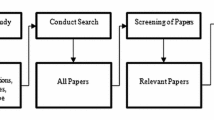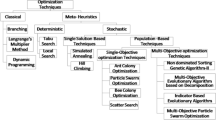Abstract
The Set Covering Problem (SCP) is a main model for several important applications, including crew scheduling in railway and mass-transit companies. In this survey, we focus our attention on the most recent and effective algorithms for SCP, considering both heuristic and exact approaches, outlining their main characteristics and presenting an experimental comparison on the test-bed instances of Beasley's OR Library.
Similar content being viewed by others
References
E. Balas, A class of location, distribution and scheduling problems: Modeling and solution methods, in: Proceedings of the Chinese-U.S. Symposium on Systems Analysis, eds. P. Gray and L. Yuanzhang (Wiley, 1983).
E. Balas and M.C. Carrera, A dynamic subgradient-based branch-and-bound procedure for set covering, Operations Research 44 (1996) 875–890.
J.E. Beasley, An algorithm for set covering problems, European Journal of Operational Research 31 (1987) 85–93.
J.E. Beasley, A Lagrangian heuristic for set covering problems, Naval Research Logistics 37 (1990) 151–164.
J.E. Beasley, OR-Library: Distributing test problems by electronic mail, Journal of the Operational Research Society 41 (1990) 1069–1072.
J.E. Beasley and P.C. Chu, A genetic algorithm for the set covering problem, European Journal of Operational Research 94 (1996) 392–404.
J.E. Beasley and K. Jörnsten, Enhancing an algorithm for set covering problems, European Journal of Operational Research 58 (1992) 293–300.
M.J. Brusco, L.W. Jacobs and G.M. Thompson, A morphing procedure to supplement a simulated annealing heuristic for cost-and coverage-correlated weighted set-covering problems, Annals of Operations Research 86 (1999) 611–627.
A. Caprara, M. Fischetti and P. Toth, A heuristic method for the set covering problem, Operations Research 47 (1999) 730–743.
A. Caprara, M. Fischetti and P. Toth, Effective solution of the LP relaxation of set covering problems, Working Paper, DEIS, University of Bologna (1998).
A. Caprara, M. Fischetti, P. Toth, D. Vigo and P.L. Guida, Algorithms for railway crew management, Mathematical Programming 79 (1997) 125–141.
S. Ceria, P. Nobili and A. Sassano, A Lagrangian-based heuristic for large-scale set covering problems, Mathematical Programming 81 (1998) 215–228.
S. Ceria, P. Nobili and A. Sassano, Set covering problem, in: Annotated Bibliographies in Combinatorial Optimization, eds. M. Dell'Amico, F. Maffioli and S. Martello (Wiley, 1997) pp. 415–428.
H.D. Chu, E. Gelman and E.L. Johnson, Solving large scale crew scheduling problems, European Journal of Operational Research 97 (1997) 260–268.
J.J. Dongarra, Performance of various computers using standard linear equations software, Technical Report No. CS–89–85, Computer Science Department, University of Tennessee (1996).
M.L. Fisher, An applications oriented guide to Lagrangian optimization, Interfaces 15 (1985) 10–21.
M.R. Garey and D.S. Johnson, Computers and Intractability: A Guide to the Theory of NPCompleteness (Freeman, 1979).
S. Haddadi, Simple Lagrangian heuristic for the set covering problem, European Journal of Operational Research 97 (1997) 200–204.
M. Held and R.M. Karp, The traveling salesman problem and minimum spanning trees: Part II, Mathematical Programming 1 (1971) 6–25.
L.W. Jacobs and M.J. Brusco, A local search heuristic for large set-covering problems, Naval Research Logistics 52 (1995) 1129–1140.
L.A.N. Lorena and F.B. Lopes, A surrogate heuristic for set covering problems, European Journal of Operational Research 79 (1994) 138–150.
C. Lund and M. Yannakakis, On the hardness of approximating minimization problems, Journal of the ACM 41 (1994) 960–981.
S. Martello and P. Toth, Knapsack Problems: Algorithms and Computer Implementations (Wiley, 1990).
P. Nobili and A. Sassano, A separation routine for the set covering polytope, in: Integer Programming and Combinatorial Optimization, eds. E. Balas, G. Cornuejols and R. Kannan, Proceedings of the 2nd IPCO Conference (Carnegie-Mellon University Press, 1992).
K.S. Al-Sultan, M.F. Hussain and I.S. Nizami, A genetic algorithm for the set covering problem, Journal of the Operational Research Society 47 (1996) 702–709.
D. Wedelin, An algorithm for large scale 0–1 integer programming with application to airline crew scheduling, Annals of Operations Research 57 (1995) 283–301.
Author information
Authors and Affiliations
Rights and permissions
About this article
Cite this article
Caprara, A., Toth, P. & Fischetti, M. Algorithms for the Set Covering Problem. Annals of Operations Research 98, 353–371 (2000). https://doi.org/10.1023/A:1019225027893
Issue Date:
DOI: https://doi.org/10.1023/A:1019225027893




